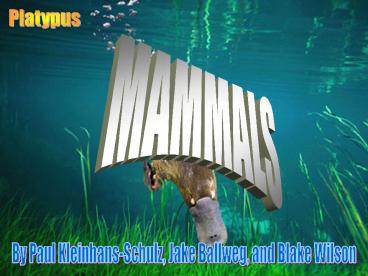MAMMALS PowerPoint PPT Presentation
Title: MAMMALS
1
Platypus
MAMMALS
By Paul Kleinhans-Schulz, Jake Ballweg, and Blake
Wilson
2
Phylum and Subclasses
- Phylum Mammalia
- Subclasses Monotremes
- Lay eggs
- Marsupials
- Very immature young, females usually have pouches
- Placentals
- Develop young in placenta when unborn
3
- Mammal Subclasses
4
Subgroups
- Orders
- Monotremata (Platypus)
- Didelphinorphia (Opossum)
- Paucituberculata (Shrew)
- Microbiotheria (Colocolo)
- Dasyuromorphia (Tasmanian Devil)
- Peramelemorphia (Bandicoot)
- Notoryctemorphia (Marsupial Mole)
- Diprotodonta (Kangaroo)
- Xenarthra (Armadillo)
- Pholidota (Pangolin)
Indri
5
Subgroups Continued
- Lagmorpha (Rabbit)
- Rodonetia (Rat)
- Macroscelidae (Elephant Shrew)
- Insectivora (Hedgehog)
- Scandentia (Treeshrew)
- Primates (Gorilla)
- Dermoptera (Cobego)
- Chiroptera (Bat)
- Carnivora (Weasel)
- Tubulidentata (Aardvark)
- Artiodactyla (Giraffe)
- Cetacea (Whale)
- Perissodactyla (Horse)
- Hyracoidea (Hyrax)
- Proboscidea (Elephant)
- Sirenia (Manatee)
Lion
6
Habitat and Food Source
- Can live anywhere from oceans to deserts to the
Arctic - Food source can be anything
- Includes
- Carnivores- meat only
- Herbivores- plants only
- Omnivores- plants and meat
Golden Lion Tamarid
7
Importance to Humans
- Humans are mammals themselves
- Provide a food source (meat products)
- Pets (dogs, cats, horses, e.g.)
Southern Elephant Seal
8
Unique Characteristics
- All have hair or fur
- Large complex brains
- Backbone
- Developed senses
- Some can swim
- Visual, vocal, and/or olfactory means of
communication - Family and social groups
- Most diverse group
Chinese Water Deer
9
For More Unique Characteristics of Mammals
Vampire Bat
10
Support Structures
- All have endoskeletons
- Endoskeleton is a skeleton inside the body
- Are made of bones
- Backbone
- Some have tails for balance
Human
11
Respiration or Gas Exchange
- Receive oxygen, release carbon dioxide
- Lungs support the high Metabolic Rate
- Lungs have Alveoli (Gas Sacs)
- Humans have 300,000,000 Alveoli
- Have a diaphragm
- Moves air in and out
Dolphin
12
Reproductive System
- Reproduce sexually
- Have a penis or uterus
- Some lay eggs
- Most have placentas
- Life cycle is
- Birth gtgt growth gtgt death
Walrus
13
Nervous/Sensory System
- All have a large complex brain
- All have a backbone
- Spinal cords which connect to muscles, organs and
skin - Nerves give them feeling
Wolves
Polar Bear
14
Circulatory System
- Warm blooded
- Blood carried from heart to the rest of the body
and back to the heart - Vessels used to transport
- Pump pushes blood (heartbeat)
Grizzly Bear
15
Video
16
Excretory System
- Blood flows to Kidney
- Ureter drains kidney
- Kidney drains into urinary bladder
- Urine exits bladder through urethra
Gorilla
17
Digestive System
- Substance is transported to stomach with
esophagus - Stomach secretes gastric acids to kill bacteria
and break down substance - Small Intestine does most of absorption of
substance - Large Intestine at end of small intestine gathers
water lost in previous processes - Waste is stored in the rectum until it is
released
Tasmanian Devil
18
Examples
Narwhal
Weasel
Wolverine
Giraffe
Groundhog
Gazelle
Human
Bison
Elephant
Kangaroo
African Wild Dog
Skunk
Blue Whale
19
Works Cited
- Bowen, Richard. Digestive System Anatomy.
About.com. 2008. 27 Mar. 2008 lthttp//www.about.c
omgt. - Carter, J. Stein. Respiratory System. UC.edu.
2004. 2 Apr. 2008 lthttp//biology.clc.uc.edugt. - Encyclopedia Britannica. Respiration Mammals.
Britannica.com. 2008. 2 Apr. 2008
lthttp//www.britannica.comgt. - Enriched Learning. All About Mammals.
Enrichedlearning.com. 2002. 6 Apr. 2008
lthttp//www.enrichedlearning.comgt. - Miller, Kenneth R. and Joseph Levine. Biology
The Living Science. Upper Saddle River, NJ
Prentice Hall, 1998. 729- 736. - Ramel, Gordon. The Mammalian Skeleton. Earth
Life. 7 Jan. 2008. 27 Mar. 2008
lthttp//www.earthlife.netgt. - Whitfield, Philip. Animals Mammals. 1 ed. 3
vols. New York, NY Macmillan. Library
Reference, 1999.
Badger

